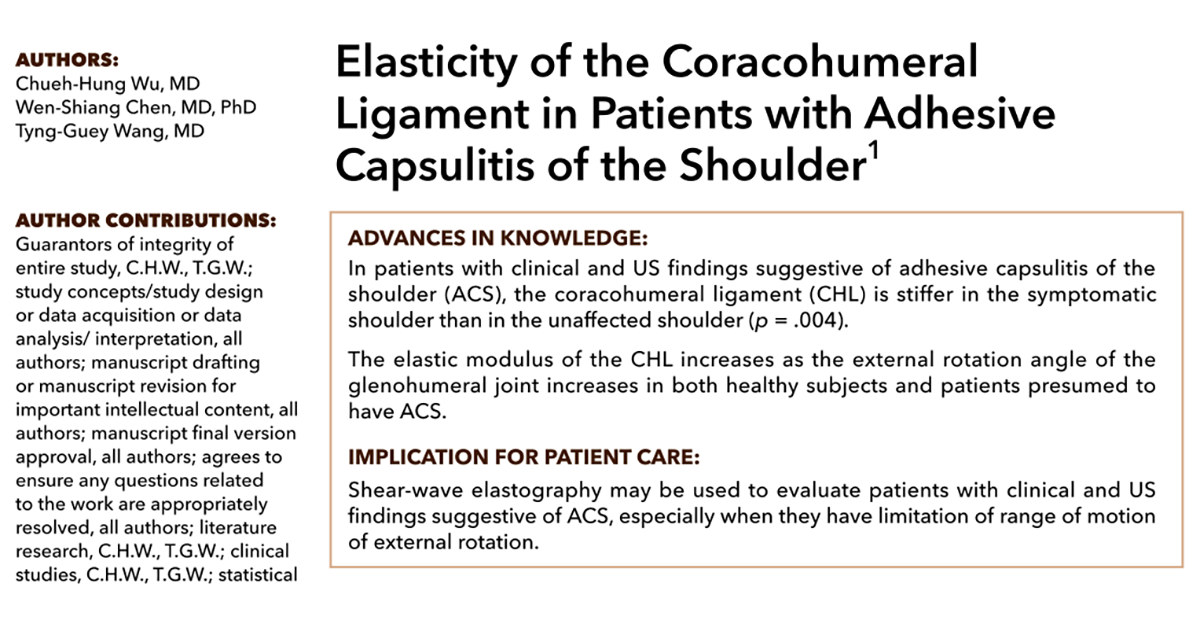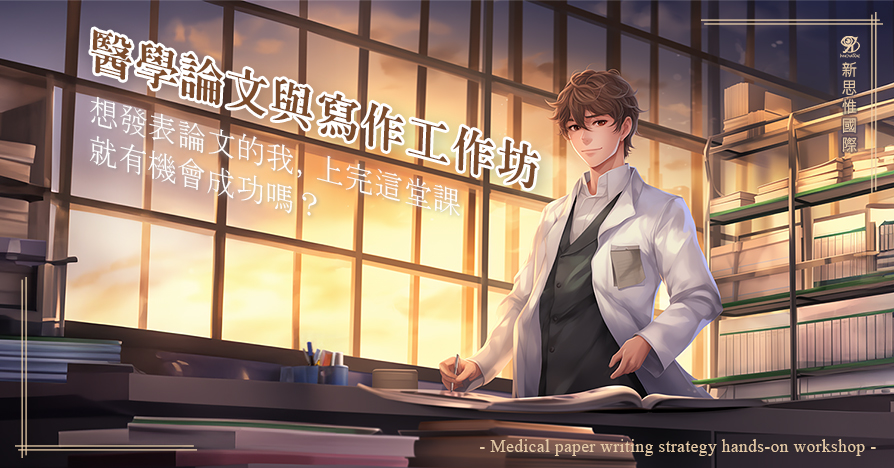
全文下載
指定論文版權說明
新思惟的《醫學論文與寫作工作坊》,使用的是吳爵宏醫師的研究,作為課程「指定論文」。這篇研究,統計全部用 MedCalc 完成,且臨床意義大,特獲頂尖期刊 Radiology 邀請,由 debuty editor 連線吳醫師,錄製 Radiology Video Podcast 向全世界播送。
多數國際期刊規範,論文的文字與圖片,屬於原作者,但「排版後」的論文,版權屬於雜誌社。所以,不管是教學或商業使用,散佈從期刊網站下載的論文 PDF,並不在授權範圍內。
也就是說,我們有時候,直接把論文 PDF 寄給同事參考,這動作事實上是「違法」的。
新思惟國際,尊重各種形式的智慧財。所以,我們取得吳爵宏醫師同意後,拿到論文的 MS-Word 版本原稿,委請設計師,用不同的風格,重新排版過。版權由「新思惟國際」回贈給吳爵宏醫師,並均能獨立使用。
這份論文,將作為這次工作坊的教材。也歡迎您在課堂上,隨時與原作者詢問討論。
論文故事

沾黏性肩關節囊炎 (Adhesive Capsulitis of the Shoulder; ACS),又名 frozen shoulder,俗稱五十肩,是常見的肩膀問題。吳爵宏醫師使用 shear-wave elastography (SWE),評估 coracohumeral ligament (CHL) 的彈性狀態 (elasticity),在「單側 ACS 患者」與「健康受測者」,是否有所不同。
在所有受測者中,CHL 彈性係數 (elastic modulus) 在肩膀 maximal external rotation 時,都明顯大於在 neutral position 時,彈性係數越大,表示越「僵硬 (stiff)」。
健康受測者,其 CHL 彈性係數,在慣用手與非慣用手側的肩膀,無顯著差異。
至於單側 ACS 患者,患側肩膀 CHL 與另一側相比,厚度較厚,neutral position 與同角度 external rotation 的彈性係數均較大,表示較為「僵硬」。但是,當肩膀 maximal external rotation 時,患側與另一側的 CHL 彈性係數則無顯著差異。
總結來說,臨床上的單側 ACS 患者,患側 CHL 相對於另一側,在 SWE 測量下,表現較僵硬 (stiffer)。
其餘細節,就請各位自行閱讀全文囉。
相關連結
- [快訊] 吳爵宏醫師 original research,獲 Radiology 刊登!
- 登上高分期刊 (impact factor > 5) 的經驗分享(吳爵宏 醫師)
- [快訊] 吳爵宏醫師獲頂尖期刊 Radiology 邀請,接受跨國線上訪談,錄製 Video Podcast!
- Radiology Video Podcast 跨國線上訪談初體驗(吳爵宏 醫師)
引用
Wu CH, Chen WS, Wang TG. Elasticity of the Coracohumeral Ligament in Patients with Adhesive Capsulitis of the Shoulder. Radiology 2016 Feb; 278(2):458-464.
摘要
Purpose: To evaluate the elasticity of the coracohumeral ligament (CHL) in healthy individuals and patients with clinical findings suggestive of unilaterally involved adhesive capsulitis of the shoulder (ACS).
Materials and Methods: The institutional review board approved this single-institution prospective study, which was performed between November 15, 2012, and July 8, 2014. Informed consent was obtained from all subjects. Measurement of CHL thickness was performed in the axial oblique plane under shoulder maximal external rotation. Shear-wave elastography (SWE) was used to evaluate elasticity of the CHL in healthy individuals (11 men, 19 women aged 22-62 years) and those with clinical findings suggestive of ACS (nine men, 11 women aged 41-70 years). SWE was performed in the shoulder-neutral position and under maximal external rotation. The Wilcoxon signed-rank test was performed to compare the thickness and elastic modulus of the CHL between bilateral shoulders.
Results: In all subjects, the CHL elastic modulus was larger under maximal external rotation than in the neutral position (p < .001 for all). For healthy subjects, there was no significant difference in the CHL elastic modulus between the dominant and nondominant shoulders. For patients presumed to have ACS, the CHL thickness was significantly greater in the symptomatic shoulder than in the unaffected shoulder (p < .001). The CHL elastic modulus of the symptomatic shoulder (median, 234.8 kPa; interquartile range [IQR], 174.4-256.7 kPa) was significantly greater than that of the unaffected shoulder (median, 203.3 kPa; IQR, 144.1-242.7 kPa) in the shoulder-neutral position (p = .004) but not under maximal external rotation (p = .123). When bilateral shoulders were maintained at the same angle of external rotation, the CHL elastic modulus was greater in the symptomatic shoulder than in the unaffected shoulder (p = .005).
Conclusion: In patients with clinical findings suggestive of ACS, SWE showed that the CHL is stiffer in the symptomatic shoulder than in the unaffected shoulder.
最新活動
